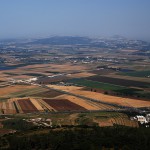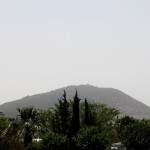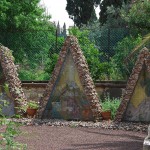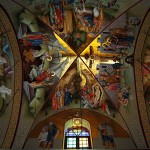Mount Tabor (Israel)
In the north-eastern part of Israel, close to the Jezreel Valley, there is a lonely elevation of Mount Tabor, which is more commonly known among people as Mount Favor or the Mount of Transfiguration. Tabor (tabur) means “central bulbous spot,” or simply “navel.” Indeed, the mountain is isolated from the rest of the mountain range and resembles a navel in its shape. The height of the mountain is 588 meters. The slopes of the mountain are covered with forests. In spring, the mountain is “transfigured” because of the wildly blossoming vegetation.
Tabor is mentioned for the first time in the Bible as the boundary of lands of three tribes of Israel: Zebulun, Issachar, and Naphtali (Joshua 19:22). Later, during the time of the Judges, Barak, accompanied by prophetess Deborah, came down with ten thousand troops from the Mount of Tabor to Kishon River and defeated the army of Sisera, who was commander of the king Jabin of Hazor (Book of Judges 4:1-24). Here, Gideon’s brothers fell from the hand of Midianite kings Zebah and Zalmunna (Judges 8:18-19).
The top of Mount Tabor from the time of Antioch the Great and up to the conquering and destruction of Jerusalem by Romans under Vespasian had always served as a fortified place. Here Roman proconsul Gabinius defeated Alexander – the elder son of Aristobulus, who fled from captivity and raised turmoil in Judea. During the First Jewish-Roman war, Mount Tabor was entrenched by Jews and Josephus Flavius for forty days against Vespasian.
These fortifications were finally torn down during Jewish revolt against Emperor Adrian. Interestingly, Joseph Flavius indicated the height of Tabor to be 10 stadia, which is more than 1.5 versts (close to 1 mile).
According to Christian tradition, it is believed that it was here – on Mount Tabor, where the Transfiguration of the Lord took place.
But most of today’s theologians believe that one of the spurs of Mount Hermon was the Mount of Transfiguration.
Before the IV century, in early Christian authorities that have survived till our days the Mount of Transfiguration is not mentioned anywhere. In the IV century, after Christianity was established as state religion of the Roman Empire, pilgrimages to Israel began. St. Helen, mother of Roman Emperor Constantine the Great, also made a pilgrimage to Israel. According to the order of St. Helen, a monastery was built on Mount Tabor. Since that time Mount Tabor was known in Christian tradition as the Mount of Transfiguration.
Whatever the traditions may be, but the event that happened to the Lord on one of the mountains in Israel is narrated in the New Testament.
Jesus Christ together with three disciples – Peter, James, and John, went up to a mountain to pray. And when Jesus prayed, “the fashion of his countenance was altered, and his raiment was white and glistering. And, behold, there talked with him two men, which were Moses and Elias: who appeared in glory, and spake of his decease which he should accomplish at Jerusalem. But Peter and they that were with him were heavy with sleep: and when they were awake, they saw his glory, and the two men that stood with him. And it came to pass, as they departed from him, Peter said unto Jesus, Master, it is good for us to be here: and let us make three tabernacles (tabernacle is a tent, a hut); one for Thee, and one for Moses, and one for Elias: not knowing what he said. While he thus spake, there came a cloud, and overshadowed them: and they feared as they entered into the cloud. And there came a voice out of the cloud, saying, This is my beloved Son: hear Him.” (Gospel of Luke 9:28-35).
On top of the mountain there are two active monasteries – Orthodox Greek convent of the Lord’s Transfiguration and Catholic Franciscan monastery with a basilica of the Lord’s Transfiguration.
The history of the Orthodox convent’s foundation has to do with the figure of archimandrite Irinarh, native of Moldova, who formerly was a monk in the Lavra (monastery) of St. Sabbas the Sanctified (Mar Saba). Not earlier than 1854, after a vision he had, he settled down on the peak of Mount Favor. Soon, after discovering the ruins of an ancient Byzantine basilica (its construction is associated with the name of St. Helen), he started to rebuild it with his helper, hierodeacon Nestor, but could not finish this endeavor, because of his death on December 25 of 1859 at the age of 93 years old; he was buried on the site of his labour. The temple was finished and dedicated in August of 1869; it has three chancels – the central one in honour of Transfiguration, the south one – in honour of prophets Moses and Elijah, and the north one in honour of St. George and Demetrius of Thessalonica. The belfry was built in 1911. The construction of the temple and monastery was mainly carried out on the means that were sent from Russia. In the monastery’s temple there is a miracle-working icon of the Holy Virgin; and in the chancel of Moses and Elijah, in the apse, one can see the stones of the ancient temple and fragments of Byzantine mosaics. On the territory that belongs to the monastery there is a cave temple of Melchizedek.
In the beginning of the XX century, in the south-west section of Mount Favor, Franciscan Monastery was built, which occupies the territory of the fort built by Moslems in the XIII century. On the ruins of the temple that dates back to Crusaders’ times and on some earlier ruins, in 1921-1924s a magnificent basilica of the Lord’s transfiguration was erected in the monastery. Prominent Italian architects Antonio and Julio Barluzzi designed and built this basilica. Close to the basilica of the Lord’s Transfiguration there are traces of the Byzantine monastery. The road that leads to the monastery goes through the so-called “Wind Gates.” The monastery keeps a small inn for pilgrims.
In 1964, Mount Favor was visited by Roman Pope Paul VI.






